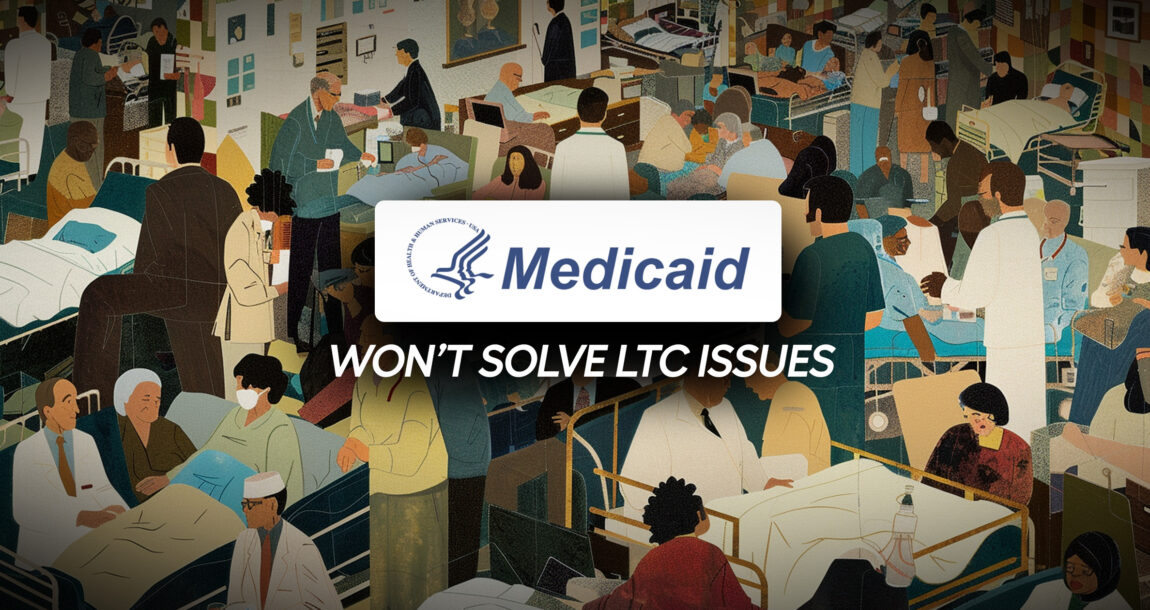Experts say Medicaid won’t solve America’s long-term care problem

In the face of mounting challenges with providing adequate and affordable long-term care options for a rapidly aging population, a director at the American Association for Long-Term Care Insurance and American Association for Medicare Supplement Insurance has cautioned that relying on Medicaid cannot be a solution all on its own.
“Programs are one option, but not really popular with taxpayers, and a patchwork solution where states have different criteria really isn’t a solution considering that people can and do move from one state to another,” Jesse Slome, director, AALTCI, said.
However, he emphasized that long-term care solutions must be sought before the matter comes to a head, a sentiment echoed by Bonnie Burns, training and policy specialist at California Health Advocates.
The CHA and other consumer groups recently issued a letter to the National Association of Insurance Commissioners Senior Issues Task Force, urging them to take more of a leadership role in directing states’ conversations about looking into options to finance long-term care coverage in respective states.
Slome likewise suggested the issue of long-term care should begin to be addressed at the state level in the absence of federal programs. States like Washington, California and a few others have already begun taking steps to introduce public financing for LTC.
“Long-term care is a matter that must be addressed, and since there is little, if any, attention at the federal level, initiatives must take place at the state level,” Slome said.
Increased spending
Without a sustainable, affordable solution for long-term care coverage, states can end up spending more on LTC, Slome said. He noted that this is a challenge on multiple levels, as Medicaid is the largest single payer of long-term care services in the country.
According to AALTCI records, Medicaid spending stood at $207 billion in 2021. In comparison, their records indicate private long-term care insurance firms paid out $12.3 billion that year. At that time, more than 84 million Americans were enrolled in Medicaid.
Meanwhile, the Kaiser Family Foundation reports that states could receive $58 billion less for Medicaid in fiscal year 2024 than in the previous year. Slome pointed out that states usually pay half of the cost of Medicaid, and “they can’t print money.”
He noted that increased spending on one end and budget cuts on the other mean states may struggle to afford other resources they need.
“State spending on Medicaid will increase, the Congressional Budget Office projects, by 17 percent,” Slome said. “States can’t address homelessness or build more schools if they are paying more for long-term care.”
Budgets already being strained
Both Slome and Burns said some states are already beginning to feel the pressure from “enormous” budget strains as a result of the increased reliance on Medicaid for long-term care.
“Medicaid is integrally tied to long-term care. So, as more people age and need care, the strain on Medicaid budgets is enormous,” Slome said.
Burns suggested that the challenge will likely be long-term as someone who becomes reliant on Medicaid for long-term care will be a state responsibility for the rest of their life.
“If people spend down to Medicaid eligibility in their state, they will be there for the rest of their life as a state responsibility,” she said.
She noted that if older Americans end up spending down through medical care and related costs through Medicare or Medicare Advantage plans, they’re still responsible for expenses like drug costs that could see them “easily spend down before they ever need long-term care.”
“Once they need it and are on Medicaid, they’re going to be there the rest of their lives, and the pressure on Medicaid is going to increase,” Burns said. “It already is.”
“States, or better said taxpayers, have to foot the bill, and thus solutions must be sought,” Slome added.
Disenrollment an added concern
Alongside this issue is the ongoing “unwinding” of Medicaid coverage, which is seeing millions of Americans lose their coverage as their eligibility is reassessed. According to Medicaid.gov, around 77 million Americans are currently enrolled. This is a notable decrease over previous years, and enrollment has slowed.
KFF reported that 18.67 million Americans have been disenrolled in the year since the process began, potentially leaving them without long-term care coverage at all.
At an NAIC meeting earlier this year, Burns told members of the Senior Issues Task Force directly that the number of aged people in their respective states will affect “a lot of different parts of your economy, specifically your state Medicaid program being one of them but a host of other things that older people need in a state economy.”
“The federal government has kicked the can down the proverbial road for decades,” Slome said. “At some point, the road ends in a cliff, and that day keeps drawing closer.”
California Health Advocates is a non-profit organization dedicated to Medicare advocacy and education in California.
The AALTCI is a national trade organization that seeks to increase consumer awareness and promote education related to long-term care insurance.
Rayne Morgan is a content marketing manager with PolicyAdvisor.com and a freelance journalist and copywriter.
© Entire contents copyright 2024 by InsuranceNewsNet.com Inc. All rights reserved. No part of this article may be reprinted without the expressed written consent from InsuranceNewsNet.com.





Fifteen California residents charged in alleged auto insurance fraud ring
Former American Income agent surrenders license in phony life app flap
Advisor News
- As tariffs roil market, separate ‘signal from the noise’
- Investors worried about outliving assets
- Essential insights a financial advisor needs to grow their practice
- Goldman Sachs survey identifies top threats to insurer investments
- Political turmoil outstrips inflation as Americans’ top financial worry
More Advisor NewsAnnuity News
- AM Best Comments on the Credit Ratings of Talcott Financial Group Ltd.’s Subsidiaries Following Announced Reinsurance Transaction With Japan Post Insurance Co., Ltd.
- Globe Life Inc. (NYSE: GL) is a Stock Spotlight on 4/1
- Sammons Financial Group “Goes Digital” in Annuity Transfers
- Somerset Reinsurance Announces the Appointment of Danish Iqbal as CEO
- Majesco Announces Participation in LIMRA 2025: Showcasing Cutting-Edge Innovations in Insurance Technology
More Annuity NewsLife Insurance News
- Proxy Statement (Form DEF 14A)
- Insurance leaders say AI a top imperative but struggle to deploy it
- Proxy Statement (Form DEF 14A)
- Proxy Statement (Form DEF 14A)
- 5 steps to overcome mistrust in life insurance sales
More Life Insurance NewsProperty and Casualty News
- Senate bill would curb home insurance rates without approval
- Boston City Council passes measure to curb ‘dangerous’ food delivery scooter operations
- Florida insurer accused of fraudulently backdating storm claims to return $30M to state
- Boston cracks down on delivery app drivers with new regulations
- Insurer rebuts new attorney general’s claim he secured $30 million to resolve fraud claim
More Property and Casualty News